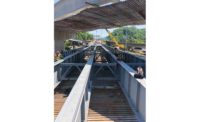
The economic and political uncertainty endemic in other sectors of the construction economy has now reached the airport design and construction market, which has enjoyed a relatively robust decade due in part to the momentum of extended project planning and implementation schedules.
“We're at the tail end of the pre-recession construction/project implementation cycle,” explains Christopher Oswald, vice president of safety and technical operations for the Airports Council International-North America. “Programs that began in the late 1990s and early 2000s are now coming to fruition.”
Among them are the $1.2-billion, 1.4-million-sq ft international terminal at Hartsfield-Jackson Atlanta International Airport; the $2.85-billion North Terminal expansion at Miami International Airport (MIA); the $1-billion Green Build program at San Diego International Airport; and the four-year, $70-million terminal and concourse renovation program at Lambert-St. Louis International Airport.
But as these programs peak and wind down, there are few new replacement taxiing up. Oswald says the indefinite shelving of O'Hare International Airport's Western Terminal exemplifies “a period of retrenchment over the last two years” in which airports have either deferred projects or sought to complete those under way in a financially sustainable way. “The focus is now on optimizing facilities already in place and will increase as facilities completed in the early 1990s reach the end of their service life,” Oswald says.
One example of an airport implementing a full facility makeover is Dallas-Ft. Worth International Airport (DFW), which began its seven-year, $1.9-billion Terminal Renewal and Improvement Program (TRIP) earlier this year. Designed to revitalize and reconfigure DFW's four 40-year-old terminals for the needs of modern air travel, TRIP includes reallocating space for security screening and passenger self-check-in kiosks—trends that didn't exist in 1974, when the airport was built—upgrading finishes and IT systems, and modernizing concessions.
“This is a chance to reset our terminals for the next 40 years,” according to DFW spokesman David Magana. “We're paying close attention to operational efficiencies, green initiatives to cut energy usage and costs, and the preferences of today's passengers.”
Compounding airports' uncertainty is the hazy future of federal support for aviation construction programs, evidenced by the summertime dispute over a stopgap funding bill for the Federal Aviation Administration, which forced a two-week shutdown of the agency. Though the relatively brief interruption had minimal effect on airport construction projects overall, particularly large-scale bond-financed projects, Oswald says airport owners now understand what their colleagues in surface transportation already knew.
“This was a wake-up call that we're in a different landscape, [regardless] of mode or federal oversight agency,” Oswald says. “Airports must now try to figure out how to gain more control of their financial destiny.”
New Approaches
One tactic is to find new sources of revenue. The South Terminal Redevelopment Program at Denver International Airport, scheduled to break ground in late October, includes a 500-room Westin hotel and conference center, a commuter rail station, and an open-air plaza with new concessions and leasable space; there will also be improvements to existing concourse and baggage systems.
Miami International is preparing to move forward with Airport City, a $500-million mixed-use project on a 34-acre tract adjacent to the airport's main entrance. The project includes two hotels, an automobile service plaza with multiple retail and convenience outlets, and one million square feet of office space.





